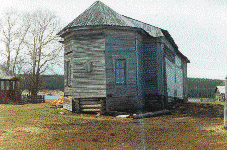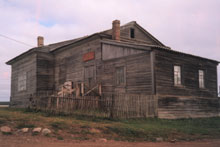|
Varzuga — The Pearl Of The Russian North The Small Indigenous Peoples of the European North Painters of the European North Konkurs (new!)
|
Varzuga — The Pearl Of The Russian North.
This ancient and amazingly beautiful Russian settlement, is located on the shores of the White Sea on the southern region of the Kola Peninsula.
The Varzuga settlement is a century older than the Kola settlement and 450 years older than the city of Murmansk itself. In bygone days, the settlement was prosperous and the centre of commerce and culture of the Russian North. This is verified by the great number of Orthodox Churches built by skilled native craftsmen. Many of the churches have been maintained and safely kept. They are all unique, as they are memorials of the wooden architecture of the Russian North. By the names of the parish churches, the left riverbank of the settlement is called Nicholskaya. The Churches in the name of St. Peter and St. Paul, the Apostles and in the name of St. Nicholas, the Miracle Maker are kept safe here. It is sad that all of these Churches were misused in times past. One of them was returned to its faithful parishioners only in 1998. The right riverbank of the settlement is called Prechistenka, as the Church in the name of the Assumption of the Mother of God located here. In addition to the Church of the Assumption of the Mother of God, religious architecture of this part of the Varzuga river includes the winter Church of St. Afanasy the Great, which was repaired some years ago by natives (the director of the collective farm was Mr. S. Kalyuzhin).
"Well-proportioned, light and ceremonial" best describes the structure of this church, which rises majestically on the high bank of the Varzuga river. Its silhouette organically flows together into the surroundings on which it stands. The overall height of the church is 34 meters, which equals the enormity of an 11-story building. The proportions of the church in all its parts and elements are excellent. One might ask, "How could illiterate craftsmen know the art to create each golden section, which gave them the opportunity to create such a harmonious and well-proportioned building?" The beauty of the church is attained not only by its elegant form, but by its exterior ornamental decoration. The building possesses a great number of varied carved elements, porch columns and window frames. The church was constructed using ordinary hand tools, such as axes and chisels. Knives where used for the craving of small details. Today, we know the name of the master craftsman who oversaw the construction of the church was Kliment. In the opinion of experts, the Church in the name of the Assumption of the Mother of God, is the premier wooden edifice of all single-domed, hip-roofed churches of the Russian North.
During its existence, the edifice of the Church of the Assumption of the Mother of God was time and again rebuilt and refashioned, making its original appearance vastly distorted. In the middle of the XIX century for example, its exterior was planked with boards. In 1947, the Church was inspected by Mr. A. Opolovnikov, an architect and famous follower of Russian wooden creative work. In 1967, Mr. N. Bystriakov, an architect of Murmansk, made a precise model of the church as it was in the XVII century. His model is now on display at the Murmansk Museum of Local Lore, History and Culture. Despite of all the changes, the church does not lose its artistic integrity, austerity or solemnity. In 1999, the edifice of the Church of the Assumption of the Mother of God was delivered back to Russian Orthodox Church. At present, the Orthodox congregation of the Varzuga settlement has the main throne here. The Senior Priest of this congregation is celibate priest Mitrophan. These are not all the miracles kept in the Russian North. The iconostasis of the Church in the name of the Assumption of the Mother of God is unique. It has 3 tiers and 84 ancient icons made in the XVII-XIX centuries. We do not know who made the icons of this iconostasis, but all of the icons require restoration. The Church of the Assumption of the Mother of God in Varzuga settlement is the national property of the Russian people, and the civil duty of the inhabitants of the Kola Peninsula is to preserve it for future generations. This booklet is published by the "Varzuga Foundation" during the action "Let's preserve Varzuga for future generations!" |
|
|
 Many centuries ago, natives of the Novgorod region chose this location which stands 30 miles from where the mouth of the Varzuga river flows into the sea.
Many centuries ago, natives of the Novgorod region chose this location which stands 30 miles from where the mouth of the Varzuga river flows into the sea.
 Nevertheless, the main pearl of the Varzuga settlement is the Church in the name of the Assumption of the Mother of God. It is unknown what happened to the original church mentioned in records from 1563, but in 1674, a new church of the same name was constructed on the location and it stands there still.
Nevertheless, the main pearl of the Varzuga settlement is the Church in the name of the Assumption of the Mother of God. It is unknown what happened to the original church mentioned in records from 1563, but in 1674, a new church of the same name was constructed on the location and it stands there still.
